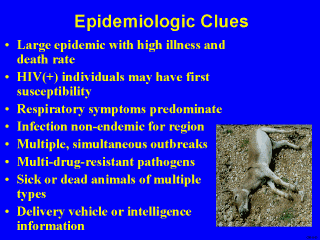 |
Symptoms that would
develop after a Biological attack would be delayed and nonspecific, making the initial
diagnosis difficult. Healthcare providers will need to especially
vigilant and look for important clues when trying to identify the cause of an unusual
infectious outbreak. A biological attack should be considered if any of the following are
present:
1. Large epidemic with unprecedented number of ill or dying.
2. Children, elderly, and those with weakened immune systems like
HIV(+)individuals, transplant patients, and those on chemotherapy may have first
susceptibility. They will likely;y be our “canaries in the coal mine”.
3. Particularly high volumes of patients complaining primarily of respiratory
symptoms that are severe and are associated with an unprecedented mortality rate.
4. The cause of the infection is unusual or impossible for the particular region
(such as the Ebola virus which is rarely seen outside of Africa). The agent may require
clinical and laboratory diagnosis.
5. Multiple, yet simultaneous outbreaks.
6. The epidemic is caused by a multi-drug-resistant pathogen, previously unknown.
7. Sick or dead animals of multiple types are encountered.
8. The delivery vehicle for the agent is identified.
9. Prior intelligence reports or claims by aggressors of a BW attack. |
